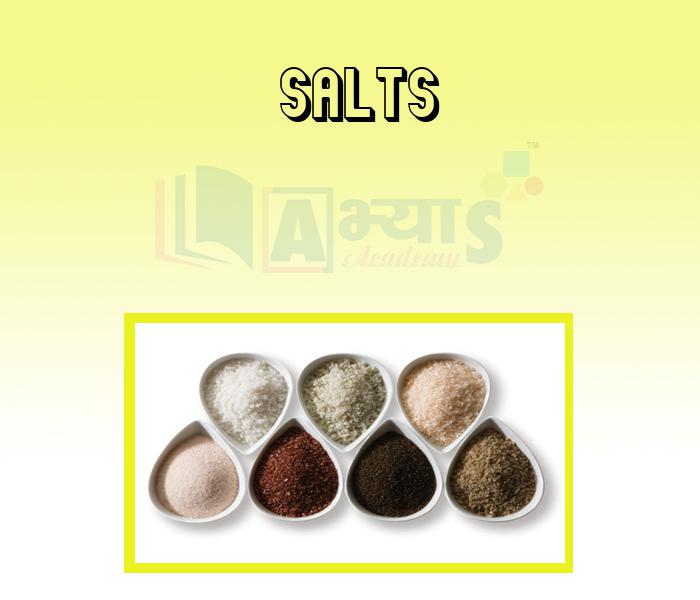Salts






Salts
Salts:
A salt is a compound formed by neutralization reaction between an acid with a base in which the hydrogen of the acid is replaced by the metal which is a part of base.
Example: The most familiar salt is sodium chloride, the principal component of common table salt. Sodium chloride, NaCl, and water are formed by neutralization reaction between sodium hydroxide( NaOH) a base, with hydrogen chloride, HCl, an acid.
In Sodium chloride (NaCl) formation positively charged ion, sodium is coming from sodium hydroxide and negatively charged ion, chlorine
is coming from hydrochloric acid.
Salt can be acidic, basic or natural.
A salt is a compound formed by _____________________ reaction. | |||
| Right Option : A | |||
| View Explanation | |||
The example of the most familiar salt is ________________________ which is the principal component of common table salt. | |||
| Right Option : B | |||
| View Explanation | |||
Which of the following are correct : (a) A salt is a compound formed by neutralization reaction between an acid with a base. (b) In Sodium chloride (NaCl) formation positively charged ion, sodium (c) The most familiar salt is sodium chloride, the principal component of common table salt. | |||
| Right Option : C | |||
| View Explanation | |||
Students / Parents Reviews [10]
Abhyas is a complete education Institute. Here extreme care is taken by teacher with the help of regular exam. Extra classes also conducted by the institute, if the student is weak.

Om Umang
10thAbhyas Methodology is very good. It is based on according to student and each child manages accordingly to its properly. Methodology has improved the abilities of students to shine them in future.

Manish Kumar
10thMy experience was very good with Abhyas academy. I am studying here from 6th class and I am satisfied by its results in my life. I improved a lot here ahead of school syllabus.

Ayan Ghosh
8thIt has a great methodology. Students here can get analysis to their test quickly.We can learn easily through PPTs and the testing methods are good. We know that where we have to practice

Barkha Arora
10thMy experience with Abhyas is very good. I have learnt many things here like vedic maths and reasoning also. Teachers here first take our doubts and then there are assignments to verify our weak points.

Shivam Rana
7thIt was a good experience with Abhyas Academy. I even faced problems in starting but slowly and steadily overcomed. Especially reasoning classes helped me a lot.

Cheshta
10thAbout Abhyas metholodology the teachers are very nice and hardworking toward students.The Centre Head Mrs Anu Sethi is also a brilliant teacher.Abhyas has taught me how to overcome problems and has always taken my doubts and suppoeted me.

Shreya Shrivastava
8thIt was good as the experience because as we had come here we had been improved in a such envirnment created here.Extra is taught which is beneficial for future.

Eshan Arora
8thI have spent a wonderful time in Abhyas academy. It has made my reasoning more apt, English more stronger and Maths an interesting subject for me. It has given me a habbit of self studying

Yatharthi Sharma
10thBeing a parent, I saw my daughter improvement in her studies by seeing a good result in all day to day compititive exam TMO, NSO, IEO etc and as well as studies. I have got a fruitful result from my daughter.
